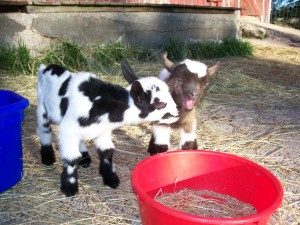About Nigerian Dwarf Goats
Some of the reasons people love this breed….
- Small and easy to handle (16” to 23” at shoulder, 40 to 90 pounds)
- Gentle nature, with individual personalities
- Wonderful pet quality
- As an approved livestock dairy breed, they are eligible for 4H and FFA projects
- A perfect fit for a small family farm
- Excellent source of dairy (milk, yogurt, cheese, etc.)
- High butterfat content compared to other breeds (valuable in cheese making and other dairy products), and milk is sweet….clean tasting and not “goaty”
- Colorful and entertaining
There is a lot of good information already out there regarding the Nigerian Dwarf goat breed and what makes them special. In order to not “reinvent the wheel” you can visit the Nigerian Dwarf Goat Association website at www.ndga.org.
FAQ: Where do I begin?
First of all….decide on your goals. Your first goal should always be healthy animals and that is reason number one to find a reputable breeder. Ask questions and be sure they’re able to mentor you in the future for any goat related questions.
“I’m just looking for pets” Wethers (neutered males) make wonderful pets and are more affordable than breeding stock. Must have at least two . Goats are herd animals and need a buddy, preferably another goat.
“I’d like to be able to have milk for my family and make cheese, yogurt, ice-cream, soap, etc.” There are a few choices I would recommend if these are your first goats:
- Purchase a “starter herd”. Two doelings and two bucklings. This may seem to be a big investment but each sex needs a buddy and you can’t keep a buck and doe together (bucklings can breed as early as 7 weeks of age). It also isn’t fair to keep them next to each other divided by a fence because goat buddies need to interact and snuggle at night. It is not a good idea to keep a buckling next to a doe. He will keep your doe cycling and he will not eat like he should, being distracted with hormones. Instead, find a separate area to keep your does from your bucks. Our bucks are kept on the opposite side of the barn from the does. If you want to have milk, you have to have bucks. Having two gives you more breeding options. If you don’t want to keep a buck, find out before you purchase your goats if there is someone who will lease a buck to you during breeding season. The problem with this route is bio-security. You can also consider AI but I’ve found it is not as reliable and not all areas have someone trained to do it. My opinion…..if you’re going to commit to this new adventure, keep your own bucks. I love my bucks! Sweet and easy to handle in this breed.
- Starter herd option #2. If you just can’t bring yourself to invest as much money, you can purchase a doeling and a wether. Next year when the doe is a year old, purchase another doe and a breeding buck. Your breeding buck, if purchased early enough in the spring will be able to breed your does in fall for spring kids and you can begin to milk then.
- Starter herd option #3. Purchase two doelings, a buck and a wether. Just a little variation from the other plans but saves you the price of a second buck. Only one problem…this doesn’t give you as many breeding options as having two bucks if you choose to keep any kids. No problem if you plan on selling all the kids.
- Starter herd option #4. Purchase two adult does in milk and get your buck the following year. If you purchase the does bred and in milk, you can keep a buck kid from one of your bred does when she kids to be a buddy to your newly purchased buck (genetic diversity).
- This is not another option but I just want to emphasize that a goat buddy is important. Many people think goats are fine alone as long as they have you for company or if they have another animal like a rabbit or chicken or horse but if you want a happy goat and want to do what’s best for the goat, then get a goat buddy please.
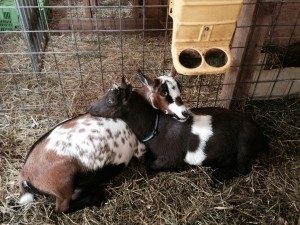
If your goals are to purchase show quality or animals with milk records, then pay attention to the symbols you see on goat pedigrees (see article about symbols on the more about goats page) and talk to your breeder regarding specific traits you are looking for in your new herd.
FAQ: What will I need for my new goats?
For anyone who is a first time goat owner, this question is a good one to ask before the new kids come home so you are prepared! This is a big question because it includes supplies, feed, and shelter set up. Below are lists of things you should have for various situations. For example, if you plan to keep two pets, you wouldn’t need many of the things you would need for two doelings who are future milkers. You also don’t feed males the same as females and females are fed differently depending on if they’re getting ready to breed, are bred, where they are in their gestation and after they kid.
Here on our farm, we believe in preventative care and raising our animals as organically as possible. That being said, to prevent health issues, there are times when using chemical wormers, antibiotics and other medications is a must and it is important to be well supplied so you aren’t left without the tools you need to care for your beloved goat. So, here is a list of things I recommend you keep for the well being of your goat.
Before I start listing, the number one thing I recommend is a great resource book. Yes, the internet is full of information but there is a lot of bad information out there too. I own many books on goat care but one I most highly recommend is pictured here. It is well worth the investment and you will save yourself a lot of time, money and peace of mind in the long run having it. This is a complete book of information with sections including natural goat remedies. A must have!!!
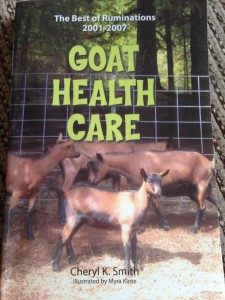
The author of this book, Cheryl K.Smith, is a breeder of Nigerian Dwarf goats who was the publisher for Ruminations: the Nigerian Dwarf and Mini Dairy Goat magazine. It is one of the most complete resources I’ve found and includes information on natural remedies too.
Wethers (pets)
- Shelter. Some sort of secure, dry structure such as a barn or shed that is not drafty, and clean, dry bedding (straw or wood shavings).
- Hay rack (keeping hay off of the ground to prevent worm load and waste)
- Hay (good quality grass mix-no mold or dust)
- Loose goat-specific mineral /baking soda feeder (small or large two compartment feeders are available). I use Sweetlix Meat Maker loose goat minerals and bulk-size baking soda from the grocery store.
- Water bucket (I like the 2 gallon so I can keep them clean and fresh). Heated buckets for winter in cold climates.
- Raw apple cider vinegar for prevention of urinary calculi in male goats. This is so important! You can mix in the goat water when you clean the pail…just a splash is all you need to prevent a very painful and sometime deadly condition.
- You do not need grain for pets but treats like animal crackers and fruits and some vegetables are great!
- Hoof trimmer (I like the orange handle ones from Jeffers or Hoeggers)
- Collar (I like the dog collars without the buckle for quick release)
Doelings (females under one year of age)
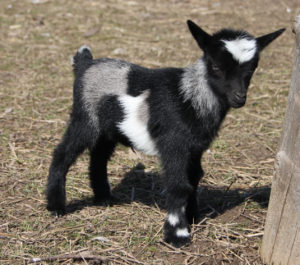 The list of supplies for young does is almost exactly the same as what you would have for wethers but if you plan to raise does who will one day be used for dairy or show you would want them to have a different diet to aid in their development. We feed our doelings mixed grass hay and some alfalfa hay. They also get about a half a cup of grain mix every day, twice a day, until a year old.
The list of supplies for young does is almost exactly the same as what you would have for wethers but if you plan to raise does who will one day be used for dairy or show you would want them to have a different diet to aid in their development. We feed our doelings mixed grass hay and some alfalfa hay. They also get about a half a cup of grain mix every day, twice a day, until a year old.
Our grain mix recipe is the following:
- 2 parts oats
- 1 part barley or wheat
- 1 part rolled corn
- 1 part black oil sunflower seed
- 1 part lactating goat pellets (optional)
- 1 part alfalfa pellets (optional)
Does and Bucks:
We use the same grain mix to feed our does in milk. They get approximately 2 cups of grain mix twice a day (on the milk stand). The amount depends on how much milk the doe produces and her body condition. Does in milk are fed mixed grass hay and alfalfa hay. Dry does and bucks are not fed grain or alfalfa hay. Bucks can be given a very small amount of grain (about 1/2 cup a day) during breeding season to help keep their weight on. Most farmer’s co-ops or feed stores may be able to mix this for you. My main objection to “goat chow” is the high amount of molasses, but if it is the only source of feed available, keep an eye on the weight and condition of your goats and increase or decrease the amount fed accordingly. Other supplies are listed in the wether section.
Kidding Supplies
- Old cotton towels for drying

- 7% Iodine for dipping navels (I use old prescription drug canisters to put iodine in)
- “Save a kid” syringe (incase you have a weak kid who needs to be tube fed)
- Nutri-drench (if needed for weak and tired doe or weak kid)
- bulb syringe (if needed for removing fluid from nose or throat)
- BoSE (vet prescription, injectable) for weak kids
- Surgical scrub, Betadine antiseptic and a lubricant(in case you need to help deliver kids)
- Diagrams of various presentations of kids in case you need it as a resource in the event you need to help difficult delivery *(Resources page has several links to articles with diagrams of dystocia (difficult deliveries) and how to correct them).
- Safe heat lamp (Premier Livestock supply has a great one). You’ll only need this if your kidding season is during a cold time of year
- Blow dryer to dry newborns (optional but, again, nice to have if you’re in a cold climate)
- Bucket of warm water with molasses in it for dam after delivery and a treat for a job well done:). They will be very tired and thirsty. Molasses for energy and the warm water encourages uterine contractions to expel the placenta.
Disbudding And Tattooing
- Disbudding iron with a goat tip
- Tattoo kit (alphabet and numbers and green ink included)
- Blue-cote (spray on area that’s been disbudded)
- Trimmer/clipper (to shave the horn bud area before disbudding and also inside ears if needed before tattooing)
- Mentor to show you how to do this the first time
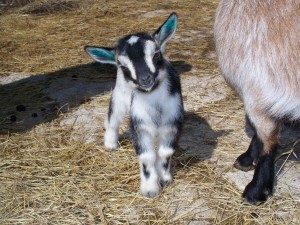 Here is where I (again) highly recommend the purchase of the Goat Health Care book I endorsed above. In this book you will find information on how to disbud and tattoo using a vet prescribed sedative. I have been using this method for many years and have used this procedure on hundreds of kids with no ill effects. The basic idea is to sedate the kid, wrap securely in a blanket (no need for box), shave the top of head, apply iron, scrape off horn buds, and apply Blue-cote. I also tattoo kids at the same time while they’re sleepy. After they’re done, I put them in a pen until they are alert enough to go back to the herd. It works GREAT!
Here is where I (again) highly recommend the purchase of the Goat Health Care book I endorsed above. In this book you will find information on how to disbud and tattoo using a vet prescribed sedative. I have been using this method for many years and have used this procedure on hundreds of kids with no ill effects. The basic idea is to sedate the kid, wrap securely in a blanket (no need for box), shave the top of head, apply iron, scrape off horn buds, and apply Blue-cote. I also tattoo kids at the same time while they’re sleepy. After they’re done, I put them in a pen until they are alert enough to go back to the herd. It works GREAT!
Milking Equipment:
- Milking stand with head restraint and feed dish for grain.
- Stainless steel milk pail
- Stainless steel strainer and milk filters
- Udder wash (I use 35% food grade hydrogen peroxide. 3-4 teaspoons and a few drops of dish soap in 2 quarts warm water)
- Teat dip (same as above)
- drying towels
- dairy soap
- sanitizer
- Mastitis testing kit
Once you start milking, you will want equipment for making cheese, yogurt, and all the other wonderful products you can now make with your amazing milk! Some sources listed on Resources page.
Medicine Chest:
- Nutri-drench (livestock supply company)
- Baking soda (feed free-choice to all goats)
- Apple cider vinegar (add a splash to drinking water for bucks and wethers)
- Goat-specific mineral (feed free choice. I use sweetlix brand Meat Maker for bucks or wethers and Magnum Milk for lactating does.)
- Probios (incase of rumen imbalance-adds good bacteria)
- Pepto Bismol (for loose stool- be sure to find out what is causing the loose stool …This is a treatment not a cure if caused by stress or change in diet, for example) Use Pepto Bismol as some other brands do not have the same ingredients.
- Electrolyte powder (for diarrhea/dehydration)
- Wormer (I use an herbal formula from Molly’s Herbal formula on a weekly basis http://www.fiascofarm.com/herbs/mollysherbals.php/categories/herbal-wormer and chemical wormers as needed. If you think your goat has an overload of worms, the best thing to do is take a fecal sample to your vet in order to find out what type of worms you’re dealing with because some wormers do not treat all types of worms.
- Dimethox/Sulfamed 40% (for treatment and prevention of coccidia. Available online.)
- Cd/t vaccine (booster given once a year. I recommend Colorado Serum /Essential 3+T . Available at Jeffers livestock online)
- BoSE (vet prescription, injection. 1cc per 40 pounds. Once or twice a year supplement for locations deficient in Selenium and for weak kids at birth)
- Copper boluses (supplement once or twice a year—only in areas deficient in copper)
- A broad-spectrum antibiotic such as Biomycin (available at farm supply stores. Keep on hand in case of infection but do not use without a vet’s recommendation or unless you are a seasoned goat owner.
- Eprinex (topical treatment for lice. Available at farm supply stores and Jeffers)
- Blu-Kote (antiseptic spray for disbudding and surface wounds)
- Nu-Stock (sulfur-based ointment for skin problems)
- Needles and syringes (20 gauge 1/2 inch needles are a good size for needles. 1cc (for small kids) and 3cc syringes. Plus a few larger syringes such as 6cc and 10cc.) available at Jeffers livestock online.
- Digital rectal thermometer
- Hoof trimmer (goats’ hooves need to be trimmed every 6-8 weeks. There are videos on YouTube demonstrating how to do it. I like the trimmers available online from Hoegger supply or Premier 1 Supplies.
- Blood stop powder. Nice to have in case you get a little close when trimming hooves.
- There are other supplies you may find yourself needing but this is a basic list to get you started. Most can be found at Fleet Farm, Tractor Supply, or orderd from livestock supply companies which I have listed on the Resources page.

